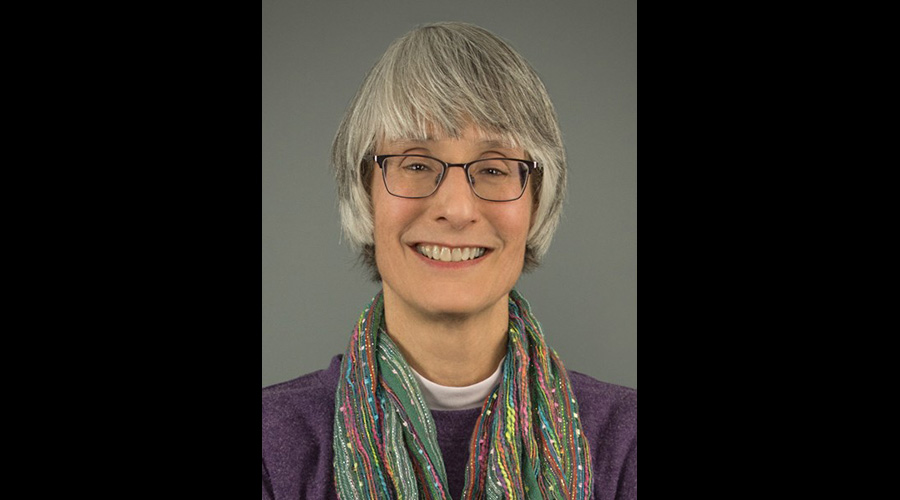A tale of two engineers: Veteran Dittmer and mid-career pro Schroedter find happy medium in balancing work, life
5/10/2024
By Julie Sneider, Senior Editor
One of Judy Dittmer’s early assignments after joining Hanson Professional Services Inc. as a civil engineer in 1984 involved a rail yard near the Clark Bridge at the Mississippi River in Alton, Illinois.
The yard was impacted by a roadway alignment that led up to the bridge, and Dittmer, a civil engineer, was brought in to help with a track removal project as part of an effort to streamline the yard’s operations.
“I remember getting field notes — that was back in the day when we had written field notes — and they had the word ‘frog’ labeled all over the place,” Dittmer says. “And I’m thinking, ‘frog?’ I was near a river, but I also knew that there were supposed to be rails there.”
Dittmer wondered if she should be on the lookout for croaking creatures in puddles near the tracks. After picking up a dictionary of rail terms, she discovered the frog in her field notes had nothing to do with amphibians.
That was Dittmer’s first encounter with railroad infrastructure. Since then, she’s provided site development, roadway and railroad design for many projects, including the Interstate 55 bridge over Lake Springfield, MacArthur Boulevard and Stanford Avenue extensions and the Capital City railroad relocation project, all in Springfield, Illinois, the home of Hanson’s headquarters.
 “The fact that Hanson realizes we're well-rounded people with lives outside of work is important to me and that certainly keeps me engaged with the company.” — Lauren Schroedter Hanson Professional Services Inc.
“The fact that Hanson realizes we're well-rounded people with lives outside of work is important to me and that certainly keeps me engaged with the company.” — Lauren Schroedter Hanson Professional Services Inc.Recently, Dittmer marked her 40th anniversary at Hanson. She joined the firm after completing a bachelor’s degree in engineering mechanics in 1982 and a master’s degree in theoretical and applied mathematics in 1983, both from the University of Illinois Urbana-Champaign. A Springfield native, she started working for Hanson as a summer intern, then parlayed the experience into a full-time position at the firm’s Springfield office after graduation.
One of the bigger railroad projects Dittmer has worked on was the Paducah and Louisville (P&L) Railroad relocation, for which Hanson was brought in to design a new 3,100-square-foot rail bridge over the Tennessee River in Kentucky. The extensive project also entailed 12,500 feet of relocated single-track line involving embankment and cut-slope designs and associated roadway and utility relocations.
The relocation of the railroad track and bridge, as well as the necessary relocation of a major highway, was part of an Army Corps of Engineers’ Kentucky Lock expansion project. Dittmer worked on the relocation’s grading and drainage elements.
“It was fascinating to me to watch how they built the railroad track and how they pulled the project all together,” she says. “I was like a kid in a candy shop.”
A project leads to a children’s book
At the time, Dittmer’s grandson was at the age when boys like to play with toy dump trucks, so she took a lot of photographs at the job site to show him.
“I had no intention of writing a book, but I was putting a bunch of the pictures together for my grandson and someone at work said, ‘Can I show that to my kids?’” Dittmer recalls. “And they showed it to their kids, and their kids liked it. Then the Hanson marketing department saw it and said, ‘We can make that look like a real book.’”
Hanson’s marketing team did indeed turn Dittmer’s photographs into a book titled, “Gong Gong and the P&L Railroad,” which chronicles her work on the project. Since then, the book has been used for public relations purposes, including distribution to employees’ children and grandchildren. Among employees who’ve shared Dittmer’s book with their children is Lauren Schroedter, a vice president at Hanson and railway discipline manager at the firm’s Bellevue, Washington, office.
“My kids have read it,” says Schroedter, an industrial engineer. “It was shared with my kids’ kindergarten class and all the kids got a copy of the book.”
Like Dittmer, Schroedter started her engineering career as a Hanson intern. She joined the firm full time in 2009 after completing her bachelor's degree in industrial engineering at Northeastern University in Boston.
In her current role, Schroedter manages the firm’s track design team and also “dabbles” in project management. The largest projects Schroedter has worked on include the BNSF Railway Co.’s Kelso-to-Longview triple-track project. Funded by the Washington State Department of Transportation and federal American Recovery and Reinvestment Act, the project was designed to relieve a major bottleneck of trains traveling into and out of the Port of Longview. The project also separated freight and Amtrak traffic to reduce congestion on shared lines.
 Schroedter was part of the Hanson team that worked on the BNSF Sandpoint Junction Connector project in Sandpoint, Idaho. The project was completed in 2023. BNSF Railway Co.
Schroedter was part of the Hanson team that worked on the BNSF Sandpoint Junction Connector project in Sandpoint, Idaho. The project was completed in 2023. BNSF Railway Co.“I was involved on the design side of that project as assistant project manager, sort of early in the design phase and then helping with the design itself,” Schroedter says. “Then, as the project progressed toward construction, I became the actual project manager, and then I was the resident engineer in the field for at least two years.”
The design included converting a siding into a mainline; constructing more than 3 miles of mainline track; adding three turnouts, five crossovers and three bridges; constructing a pier protection wall at a highway grade separation; and modifying one road crossing.
More recently, Schroedter was part of the Hanson team that worked on the BNSF Sandpoint Junction Connector project in Sandpoint, Idaho. Hanson served as design engineer for the project, in which BNSF built a second track and rail bridges over Lake Pend Oreille, Sand Creek and Bridge Street in Sandpoint. The project was necessary to alleviate freight-rail traffic congestion. BNSF’s inaugural train trip across the new connector took place Aug. 6, 2023.
“I was helping with the integration of telecom design into the structure and coordinating between those telecom elements and the structural engineers. And then I was involved in some of the [quality control] elements,” Schroedter says. “It was a huge project. Even though my role was a little smaller, it was still really cool to work on.”
Currently, Schroedter is working on the design team for a handful of other projects involving Norfolk Southern Railway. Among Dittmer’s latest assignments is the long-running Springfield Rail Improvements Project, a $475 million effort to relocate all passenger- and freight-rail traffic from the Third Street corridor to Tenth Street; construct roadway underpasses at critical rail crossings on both the Tenth and Nineteenth street corridors; and eliminate train horns in the city between Stanford Avenue and Sangamon Avenue.
Thoughts about filling a talent gap
Both Dittmer and Schroedter are representative of key demographic flashpoints in the engineering workforce: Born in 1960, Dittmer is a member of the baby-boom generation facing retirement; born in 1986, Schroedter is at a point in her career when many female engineers choose to leave the engineering workforce for positions outside the field. Dittmer’s and Schroedter’s personal career stories could be considered potential solutions for a profession grappling with a shortage of engineers that’s only expected to grow.
According to a December 2023 report by Boston Consulting Group and SAE International, “Much of the engineering gap expected in the U.S. over the next 10 years will involve unfilled positions in software, industrial, civil and electrical engineering, amounting to a staggering 186,000 job vacancies across the U.S. by 2031.”
The BCG and SAE report also notes that the engineering profession has “long struggled to broaden its diversity and inclusiveness.”
“Despite significant investment and numerous programs aimed at reducing the gender gap in engineering, just 16% of U.S. engineers are women, according to an analysis of 2022 Bureau of Labor Statistics (BLS) data,” the report states.
Meanwhile, the Society of Women Engineers (SWE) reported in 2021 that retaining women in the engineering workforce is an “urgent matter.” Citing data from the National Center for Science and Engineering Statistics, SWE found that in 2021, 53.4% of women with engineering degrees who graduated within the last one to five years (before 2021) worked in engineering roles, compared to 49.3% of their male counterparts. But when examining trends for women who completed their engineering degrees 11 to 15 years before 2021, only 26.8% were still working as engineers.
“The gender gap in engineering retention raises concerns about the underlying causes influencing women’s career paths,” the SWE reports on its website.
Asked what they would recommend that would help fix the profession’s talent gap, Dittmer and Schroedter both emphasized that working for a family-friendly employer has made a major difference in their ability to continue working as engineers after they became parents. Dittmer, who has two daughters and four grandchildren, says she’s spent 40 years at Hanson because each project presented interesting challenges she’s continued to learn from.
“Everything I’ve worked on has been worthwhile,” she says. At the same time, she’s been able to work close to home and her family.
“Hanson, I think, has always been a family-oriented company,” Dittmer says. “I had no motivation to change [employers] because I was in a place that took good care of us and our families.”
Schroedter, the mother of a five-year-old and a seven-year-old, says 40 hours a week “is the norm” for Hanson engineers, something that’s appreciated by mothers and fathers.
“I've heard of peers in the industry where overtime is the norm,” Schroedter says. “That doesn't really work for me with a family. I'm not at that point in my life where I desire 80-hour weeks. Both my husband and I work, and we equally share the parenting. The fact that Hanson realizes we're well-rounded people with lives outside of work is important to me and that certainly keeps me engaged with the company.”
Dittmer hopes her book might have encouraged a few children to think about engineering as a career choice. But she’s concerned when she hears young people say they can’t be engineers because they’re “not good at math.” She believes the engineering profession, perhaps through its associations, should do more to communicate to students that being an engineer involves more than math skills.
“Maybe it would make a difference if we [in the profession] encouraged them to focus on what they are good at and realize that a STEM career is really a spectrum of careers; it’s all not high-level mathematics,” she says.
Dittmer and Schroedter also believe more should be done to educate potential engineering students in communication, team-building and other “soft” skills necessary to be successful in the engineering business.
“When you get out into the workplace, the fact that you know every engineering equation is not what your employer's going to care about,” says Schroedter. “They're going to care about your ability to work with people; your ability to identify what you know and whether you can ask appropriately when you don't know something; and whether you continuously learn and develop your skills. It’s a lot of that softer side that really brings out the stars in the industry.”


